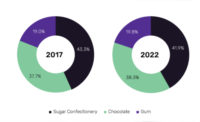If you want to have a good idea of the Japanese confectionery market one must start by analyzing where chocolate consumption stands, particularly since it’s increasing.
The chocolate segment in Japan managed to reach 6 percent current value growth (ACG) last year, reaching a staggering amount of 552 billion yen ($5.1 billion) in retail sales. Part of the growth can be attributed to the way people view chocolate and the health benefits of cacao.
One must understand Japan’s demographics before making any statement about the chocolate confectionery market. The fact that the population is decreasing each year makes it even more remarkable that chocolate segment managed to show growth in retail volume and value since 2013.
As detailed in the accompanying article, it is only recently that people’s minds in Japan have shifted their views toward chocolate, specifically its healthy aspects. The perception of chocolate is no longer one surrounded about concerns about fat or sugar.
For instance, enough data and research supports claims that polyphenols in cacao can be effective for improving health in many ways. Reports about this in local media has contributed to increased consumer awareness.
Cacao contains a good balance of minerals, for instance calcium, magnesium and iron, which can help reduce one’s blood pressure as well as prevent arteriosclerosis, cancer and obesity, And let’s not forget it’s ability to minimize stress. These are all crucial aspects that have helped make chocolate an important player in the confectionery market. Any U.S .players wanting to enter the Japanese market could benefit from underscoring these better-for-you aspects of chocolate.
As of now, chocolate is expected to record a growth with a value CAGR of 4 percent at constant 2016 prices over the forecast period to reach 682 billion yen ($6.25 billion) in 2021. Given that chocolate’s health benefits are continuously promoted by multiple parties (government, media and producers), manufacturers are expected to continue to develop products that further emphasize these attributes.
The boon in chocolate sales can be seen in the increasing number of chocolate specialty shops popping up. Also, the fact that these shops are eager to combine chocolate with vegetables and other products that are considered healthy, should further drive this growth, dovetailing with Japanese consumers’ focus on health.
At the moment, Meiji Co. Ltd. is the market leader in total confectionery sales in Japan, with about a 12 percent share of the market in 2016. This can be partially attributed to its large share in chocolate confectionery. The company helped its own cause when it convinced a large part of the Japanese population of the healthy benefits of chocolate through a campaign highlighting its own research and data.
Then there are other noteworthy trends to be highlighted. For instance, gum is becoming less popular among Japanese consumers. Although it still showed a 1 percent increase in current value — 138 billion yen ($1.26 billion), which is attributed to the success of sugar-free gum — the decline of smokers in the past decade has led to an accompanying steady decrease in gum consumption overall.
The short growth from 2015 onward can’t take away the pessimism surrounding a decade of negative growth for the gum industry. As the government is increasingly making an effort to ban smoking from restaurants and cafes, it is likely the gum industry will further decline in Japan.
The main stakeholder in the gum industry is Lotte Co. Ltd., with a staggering 51 percent share of the market in 2016. Mondelez Japan Ltd. ranks second with 23 percent of the market. As a result, the negative growth of gum in Japan has stalled interest in new product development, typically a driver in creating excitement and sales. This, naturally, doesn’t bode well for the future.
As regards sugar confectionery, this segment was projected to post a 2 percent gain in 2016 of 375 billion yen ($3.4 billion), driven mostly by the great performance in pastilles, jellies and mints. Despite the declining population, sugar products are gaining momentum, which can be further illustrated by the fully packed sugar confectionery displays inside the convenience stores across Japan.
As Japanese people often do their shopping in such small supermarkets, these stores usually represent the type of foods and drinks consumers are interested in. The large presence of such confections symbolizes how familiar Japanese have become with Western-style sugar products.
No surprise that Japanese sugar manufacturers have continued their efforts to remove any sort of negative perceptions of buying and eating candy and snacks among local consumers. Traditionally, the Japanese believe that eating candy in between or outside of the three meals they eat per day, will lead to weight increase. Yet, this negative response is slowly but steadily slipping away.
Japanese manufacturers coined the term Tekiji-syoku, which basically says that being hungry can increase blood sugar level highs when one next eats. It paved the way of the idea that snacking in between meals is not so bad after all, thus changing people’s attitude toward snacking overall. Hence, eating light snacks can take away the guilt feeling of eating in between meals.
If we look at the sugar confectionery market Asahi Group Foods Ltd. is consolidating its position as market leader with a convincing 10 percent retail value share during the year 2016. Asahi mainly produces mints, boiled sweets and medicated confectioners. They are particularly present in their power mints department, with a 54 percent share in 2016. The main product is Mintia, a product that has been around for 20 years now. But thanks to adding flavors over time, adjusting texture, and revamping packaging design, the product continues to be relevant for consumers.






